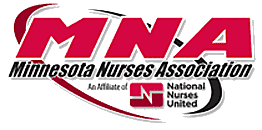

Share
Nurses filed 3,000 reports of unsafe care in 2016, according to the annual “Concern for Safe Staffing Report” issued by the Minnesota Nurses Association.
Registered Nurses detailed hospital care where patients didn’t receive medications, assessments, and treatments because not enough nurses were scheduled to work a shift. The analysis shows the number of these incidents rose 9.45 percent in 2016 compared to the number filed in 2015.
Download a PDF file of the report here.
“Nurses document their shifts when they don’t have enough qualified staff to care for the number of patient assignments and their conditions,” said Carrie Mortrud, RN, chief author of the report. “This year they told us that even when they told supervisors they were short staff, management didn’t provide needed help or substituted nurses who were brand new to the hospital or untrained to the unit that needed help. That’s a disaster waiting to happen.”
Nurses reported nearly 50 percent of the time patient medications were not administered according to the physician’s orders. More analysis showed patient wait times rose 11 percent in 2016; an “inability to answer call lights” was reported 1,151 times; and patients being unable to be seen due to the nurses not being able to accept the patient assignment rose 228 percent year-to-year.
“We’ve had issues with extremely sick patients who needed two nurses but only got one,” said Laurie Bahr, a Registered Nurse who has repeatedly filed CFSS forms. “One night we told management we couldn’t take any more admissions at 5 p.m., but we stayed open until 9:45 that night without any more nurses on duty.”
The CFSS forms also capture the response by hospital supervisors when nurses indicate more staff is needed to care for patients during that shift. Nurses reported a dramatic increase in supervisors having to accept a patient assignment or a new, untrained nurse being thrust into a unit to pick up the slack.
“Nurses float to different departments all the time,” Mortrud said, “but the danger is when unqualified staff, such as a new nurse still in orientation or a seasoned nurse who typically works in a different environment must care for patients or use equipment they don’t know. Imagine if you’re a plumber being told to install an electric outlet. The work won’t be up to par, and in a hospital, patient safety is the work.”
“Our conclusion is that the continued increase in unsafe staffing shows that we need a coordinated response from our state’s regulatory agencies to address this issue,” said Mathew Keller RN JD, co-author of the report.
Some categories of unsafe patient care did see decreases from 2015-2016. Patients leaving the hospital against medical advice (AMA) or without being seen decreased almost 5 percent; patient falls or patient safety at risk dropped 1.75 percent; and fewer nurses reported working extreme overtime (more than 16 consecutive hours) by 4.35 percent.

